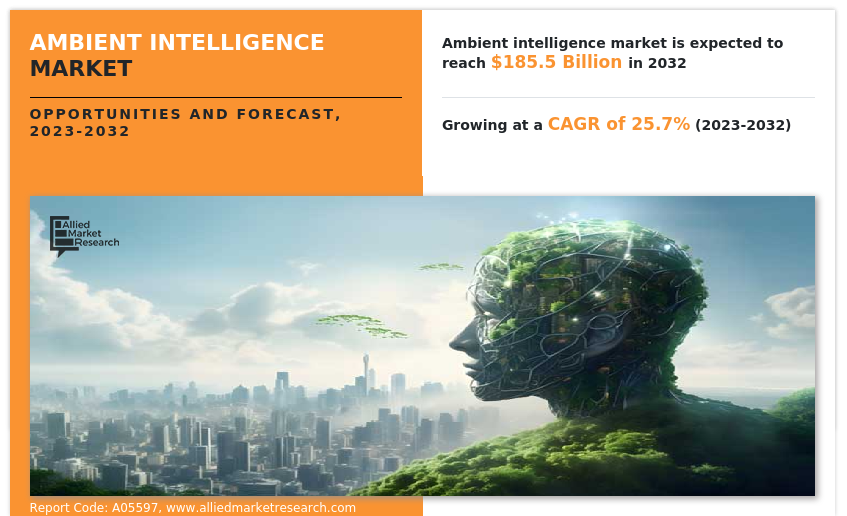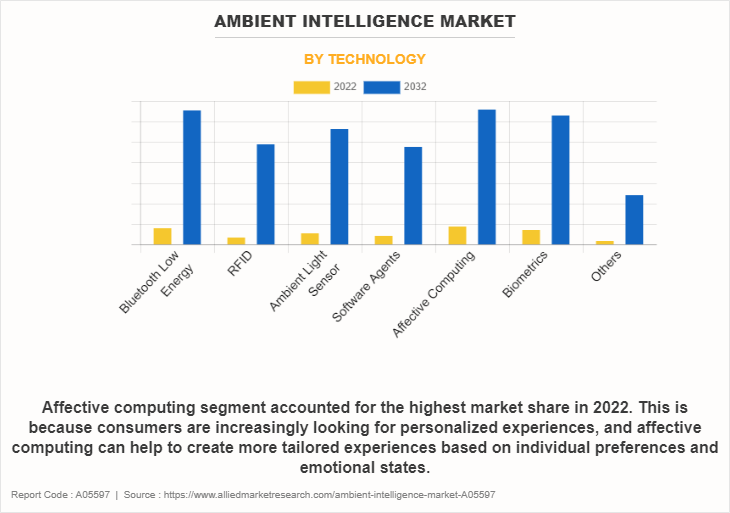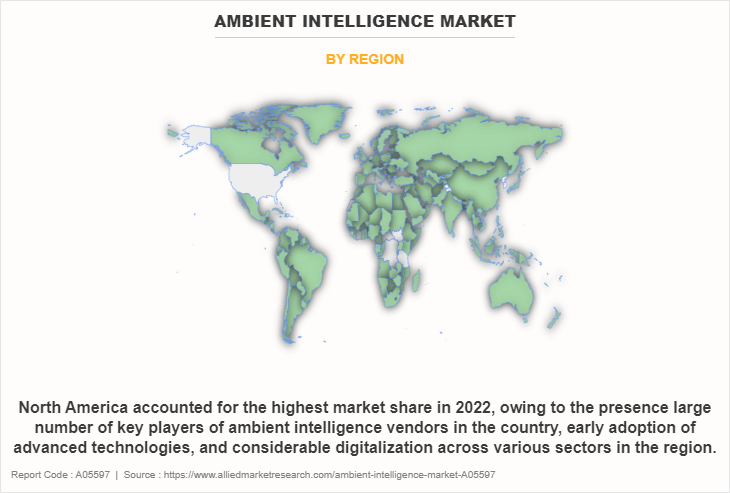Ambient Intelligence Market Statistics, 2032
The global ambient intelligence market was valued at $19.2 billion in 2022, and is projected to reach $185.5 billion by 2032, growing at a CAGR of 25.7% from 2023 to 2032.
The major factors driving the growth of the ambient intelligence market include the increase in adoption of smart homes & the development of connected and autonomous vehicles. Smart home appliances are gaining popularity due to their convenience, efficiency, and security. These devices are widely used in residential systems to perform tasks such as heat regulation, lighting control, and switching on/off electronic devices. In addition, increase in demand for smart healthcare devices is considered an important factor to boost the ambient intelligence market.

Ambient intelligence refers to a pervasive and responsive environment that leverages sensors, artificial intelligence, and connectivity to enhance user experiences and automate tasks seamlessly. The main use of ambient intelligence is to create smart, context-aware environments that can anticipate and respond to the needs of individuals or groups of people without requiring explicit commands or interactions.
However, higher implementation cost and the concern about privacy and security are expected to hamper market growth. Deploying ambient intelligence technology requires a large upfront investment and can be prohibitively expensive for many businesses. Implementing ambient intelligence systems often requires a substantial upfront capital investment. This includes the cost of sensors, connectivity infrastructure, software development, and integration with existing systems. For businesses and homeowners, this financial commitment can be a barrier to entry.
On the contrary, rise in development of advanced sensors contribute significantly to the growth of the ambient intelligence market. Advanced sensors are equipped with greater accuracy and sensitivity, which allows them to capture of more environmental data. This consists information on temperature, humidity, air quality, lighting conditions and sound levels. This enhanced perception capability is essential for ambient intelligence systems to create more responsive and adaptive environments.
The report focuses on growth prospects, restraints, and trends of the ambient intelligence market analysis. The study provides Porter’s five forces analysis to understand the impact of various factors, such as bargaining power of suppliers, competitive intensity of competitors, threat of new entrants, threat of substitutes, and bargaining power of buyers, on the ambient intelligence market.
Segment Review
The ambient intelligence market is segmented on the basis of component, technology, end user, and region. On the basis of component, the market is categorized into hardware, software, and service. On the basis of technology, the market is divided into bluetooth low energy, RFID, ambient light sensor, software agents, affective computing, biometrics, and others. On the basis of end user, it is divided into residential, retail, healthcare, office building, automotive, and others. On the basis of region, it is analysed across North America, Europe, Asia-Pacific, and LAMEA.

On the basis of technology, the affective computing segment attained the highest ambient intelligence market size in 2022, because consumers are increasingly looking for personalized experiences, and affective computing can help to create more tailored experiences based on individual preferences and emotional states.

On the basis of region, North America held the highest ambient intelligence market share in 2022, owing to factors such as the presence large number of key players of ambient intelligence vendors in the country, early adoption of advanced technologies, and considerable digitalization across various sectors in the region.
The report analyzes the profiles of key players operating in the ambient intelligence market such as Schneider Electric S.E., Siemens AG, ABB Group, Johnson Controls, Infosys, Honeywell International, Inc., BioIntelliSense, Inc., Nuance Communications, Inc., Eyeris Technologies, Inc., and Accel Robotics. These players have adopted various strategies to increase their market penetration and strengthen their position in the ambient intelligence market.
Top Impacting Factors -
Increase in demand for smart healthcare devices
Smart health devices are becoming popular, owing to their ability to provide real-time health information to users. These devices monitor heart rate, blood pressure, temperature, and other vital signs and can be monitored remotely. This allows timely detection of any changes in health and enables timely medical intervention when needed. In addition, the COVID-19 pandemic accelerated the adoption of remote patient monitoring (RPM). Smart healthcare devices enable healthcare providers to remotely track patients' vital signs, chronic conditions, and post-operative recovery, reducing hospital readmissions and improving patient outcomes.
Furthermore, growing interest in health and fitness drives the demand for wearable smart devices. Consumers are using these devices to track their physical activity, sleep patterns, and nutrition, leading to a more health-conscious life. Moreover, regulatory agencies are increasingly recognizing the value and safety of smart healthcare devices. This support is encouraging innovation in the healthcare technology sector and boosting investor confidence. Therefore, increase in demand for smart healthcare devices drives the growth of the ambient intelligence industry.
Development of connected and autonomous vehicles
Autonomous vehicles are designed to prioritize safety and efficiency. They rely on ambient intelligence systems to navigate and interact with their environment. These systems can communicate with other vehicles, delivering traffic management systems that create a safer and more accurate travel environment. In addition, businesses and logistics companies are increasingly adopting CAVs for transportation and delivery services. Ambient intelligence plays a crucial role in optimizing fleet management, ensuring on-time deliveries, and reducing operational costs through real-time tracking and route optimization.
Further, as CAV technology matures and gains public trust, more people will embrace the concept of autonomous transportation. This increase in acceptance is expected to drive the demand for ambient intelligence systems that enhance the safety and convenience of connected and autonomous vehicles.
Increase in adoption of smart homes and buildings
Smart home appliances are gaining popularity due to their convenience, efficiency, and security. These devices are widely used in residential systems for functions such as heat regulation, lighting control, and switching electronic devices. In addition, ambient intelligence enhances the user experience in smart homes and buildings by creating personalized and responsive environments. For instance, based on user preferences and patterns, ambient intelligence can adjust lighting, heating, and entertainment systems to create a more comfortable and convenient space.
Furthermore, ambient intelligence leverages data from sensors and devices to predict when maintenance or repairs are needed. This proactive approach reduces downtime, extends the lifespan of equipment, and minimizes operational disruptions. This growing demand for smart home appliances drives the growth of the ambient intelligence industry.
Higher implementation cost and concerns about privacy and security
Deploying ambient intelligence technology requires a large upfront investment and can be prohibitively expensive for many businesses. Implementing ambient intelligence systems often requires a substantial upfront capital investment. This includes the cost of sensors, connectivity infrastructure, software development, and integration with existing systems. For businesses and homeowners, this financial commitment can be a barrier to entry. Moreover, retrofitting existing buildings with ambient intelligence technologies can be costlier than incorporating them during the initial construction phase. This retrofit cost discourages building owners from adopting these solutions, especially for older structures.
Furthermore, ambient intelligence systems can become targets for cyberattacks. Unauthorized access to data or control of smart devices can result in data breaches, privacy violations, and even physical security risks. In addition, security breaches or privacy violations can severely damage the reputation of companies that provide ambient intelligence solutions. This can result in legal consequences and a loss of customer trust.
Rise in adoption of big data analytics
Big data analytics empowers ambient intelligence systems to make informed, data-driven decisions. By processing and analyzing the massive amounts of data generated by smart sensors, devices, and IoT infrastructure, ambient intelligence systems can optimize various aspects of the environment, such as energy usage, security, and user experience. Moreover, big data analytics enables real-time monitoring of ambient intelligence systems. It can quickly identify anomalies, trends, and patterns in data, allowing for immediate responses to changes in the environment. For instance, in a smart building, real-time analytics can adjust heating and cooling systems based on occupancy and external weather conditions.
In addition, big data analytics plays a pivotal role in personalizing user experiences in smart environments. It can analyze user behavior, preferences, and usage patterns to tailor lighting, climate control, and other settings to individual preferences, enhancing comfort and satisfaction. Furthermore, businesses and organizations benefit from improved operational efficiency and cost savings through big data analytics in ambient intelligence. By optimizing processes, resource usage, and workflows, companies can reduce expenses and enhance competitiveness. Thus, all these factors are expected to provide lucrative opportunities for the growth of the market.
Rise in development of advanced sensors
Advanced sensors are equipped with greater accuracy and sensitivity, which allows them to capture of more environmental data. This consists information on temperature, humidity, air quality, lighting conditions, and sound levels. This enhanced perception capability is essential for ambient intelligence systems to create more responsive and adaptive environments. In addition, advanced sensors often support multiple sensing modalities in a single device.
For instance, a sensor can combine temperature, humidity, and motion detection. This multimodal sensing provides a comprehensive view of the environment, enabling better control and decision-making. Moreover, many advanced sensors are equipped with wireless communication capabilities, such as Bluetooth and Wi-Fi. This wireless connectivity simplifies the deployment of ambient intelligence systems and facilitates data transmission to central processing units. Therefore, these trends are expected to drive ambient intelligence market growth.
Market Landscape and Trends
The ambient intelligence market is expanding due to the growing demand for sustainable and energy-efficient solutions. The technology uses sensors and sophisticated computing to create a more sustainable environment and reduce energy. Eco-friendly technologies provide comprehensive answers to problems of sustainability and environmental degradation through energy efficiency and resource efficiency reduction, and the development of the Internet of Things played an important role in environmental intelligence. The proliferation of IoT devices and the development of improved connectivity solutions such as 5G have contributed to the expansion of AmI applications.
Furthermore, governments across the globe are investing heavily in ambient intelligence, while increasing adoption of nanotechnologies, smart technologies and autonomous cars are all contributing to the expansion of the market, which is expected to propel the market growth during the forecast period.
Key Benefits for Stakeholders
- This report provides a quantitative analysis of the market segments, current trends, estimations, and dynamics of the ambient intelligence market forecast from 2022 to 2032 to identify the prevailing market opportunities.
- Market research is offered along with information related to key drivers, restraints, and opportunities of ambient intelligence market outlook.
- Porter's five forces analysis highlights the potency of buyers and suppliers to enable stakeholders to make profit-oriented business decisions and strengthen their supplier-buyer network.
- In-depth analysis of the ambient intelligence market segmentation assists in determining the prevailing ambient intelligence market opportunity.
- Major countries in each region are mapped according to their revenue contribution to the global market.
- Market player positioning facilitates benchmarking and provides a clear understanding of the present position of the market players.
- The report includes an analysis of the regional as well as global ambient intelligence market trends, key players, market segments, application areas, and market growth strategies.
Ambient Intelligence Market Report Highlights
| Aspects | Details |
| Market Size By 2032 | USD 185.5 billion |
| Growth Rate | CAGR of 25.7% |
| Forecast period | 2022 - 2032 |
| Report Pages | 429 |
| By Component |
|
| By Technology |
|
| By End User |
|
| By Region |
|
| Key Market Players | Nuance Communications, Inc., Schneider Electric, Johnson Controls, BioIntelliSense, Inc., Siemens AG, ABB Group, Honeywell International, Inc., Eyeris Technologies, Inc., Infosys, Accel Robotics |
Analyst Review
Sustainability also drives the use of low-power sensors and processors in IoT devices, thereby making them more energy-efficient and cost-effective in addition to facilitating their integration into AmI. Moreover, ambient intelligence provides educators with a wealth of data on student behavior and performance, which can be used to inform decision-making at the individual and institutional levels. Increase in availability of advanced technologies, such as sensors, machine learning algorithms, and artificial intelligence, has made it easier and more cost-effective to implement ambient intelligence in the education sector. Furthermore, growing consumer awareness of the benefits of ambient intelligence and availability of smart devices led to increase in adoption of ambient intelligence solutions In addition, deployment of high-speed, low-latency connectivity technologies such as 5G and Wi-Fi 6 enables seamless communication between devices and enhances the capabilities of ambient intelligence systems. Therefore, these factors are expected to provide lucrative opportunities for the ambient intelligence market growth.
The market players have adopted strategies such as collaboration for enhancing their services in the market and improving customer satisfaction. For instance, in March 2022, Cerner and Nuance expanded their collaboration to further integrate Nuance Dragon Ambient eXperience technology into Cerner's Millennium electronic health record. The companies expect that expanded DAX integration will assist hospitals and health systems in better managing the increasing administrative workloads that contribute to clinician burnout. Such strategies are anticipated to boost the growth of the ambient intelligence market.
Moreover, some of the key players profiled in the report are Schneider Electric S.E., Siemens AG, ABB Group, Johnson Controls, Infosys, Honeywell International, Inc., BioIntelliSense, Inc., Nuance Communications, Inc., Eyeris Technologies, Inc., and Accel Robotics. These players have adopted various strategies to increase their market penetration and strengthen their position in the industry.
The ambient intelligence market is estimated to grow at a CAGR of 25.7% from 2023 to 2032.
The ambient intelligence market is projected to reach $185.50 billion by 2032.
Increase in demand for smart healthcare devices, development of connected and autonomous vehicles, and increase in adoption of smart homes and buildings contribute towards the growth of the market.
The key players profiled in the report include ambient intelligence market analysis includes top companies operating in the market such as Schneider Electric S.E., Siemens AG, ABB Group, Johnson Controls, Infosys, Honeywell International, Inc., BioIntelliSense, Inc., Nuance Communications, Inc., Eyeris Technologies, Inc., and Accel Robotics.
The key growth strategies of ambient intelligence players include product portfolio expansion, mergers & acquisitions, agreements, business expansion, and collaborations.
Loading Table Of Content...
Loading Research Methodology...


